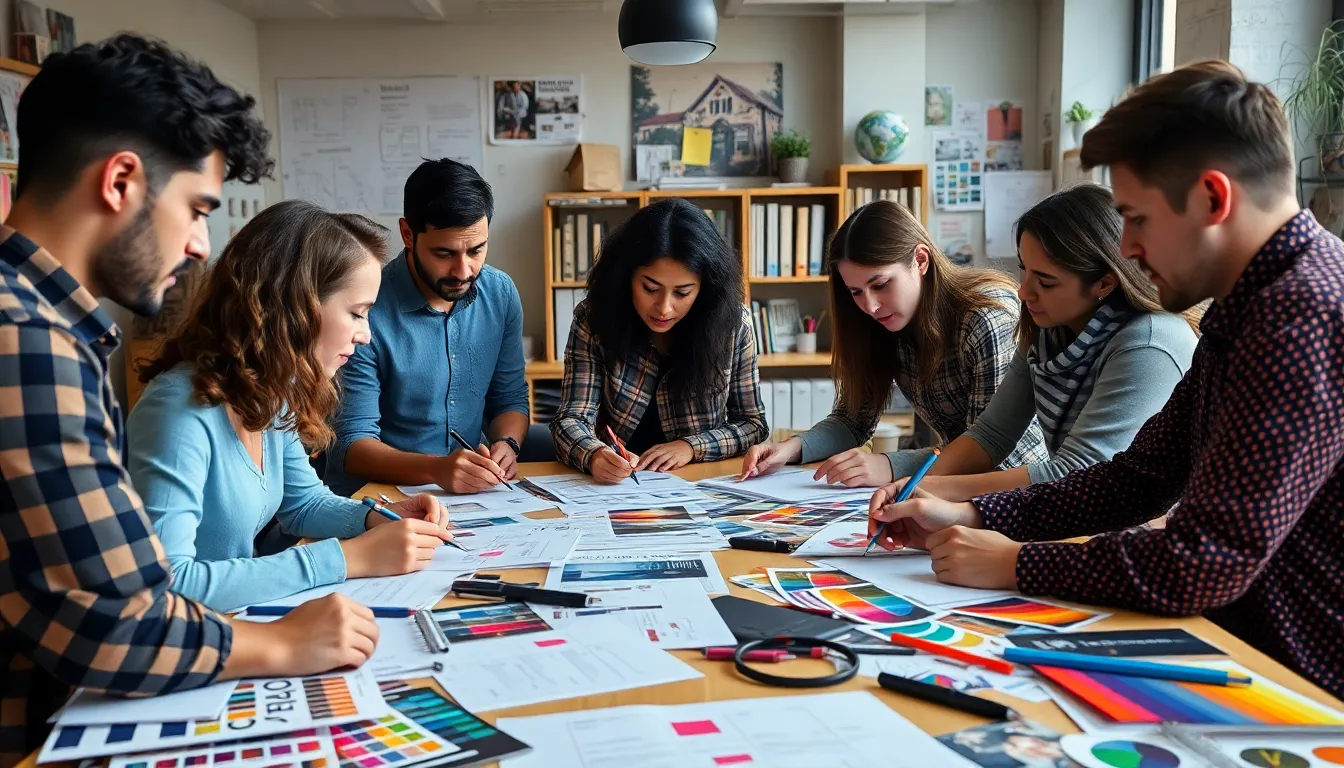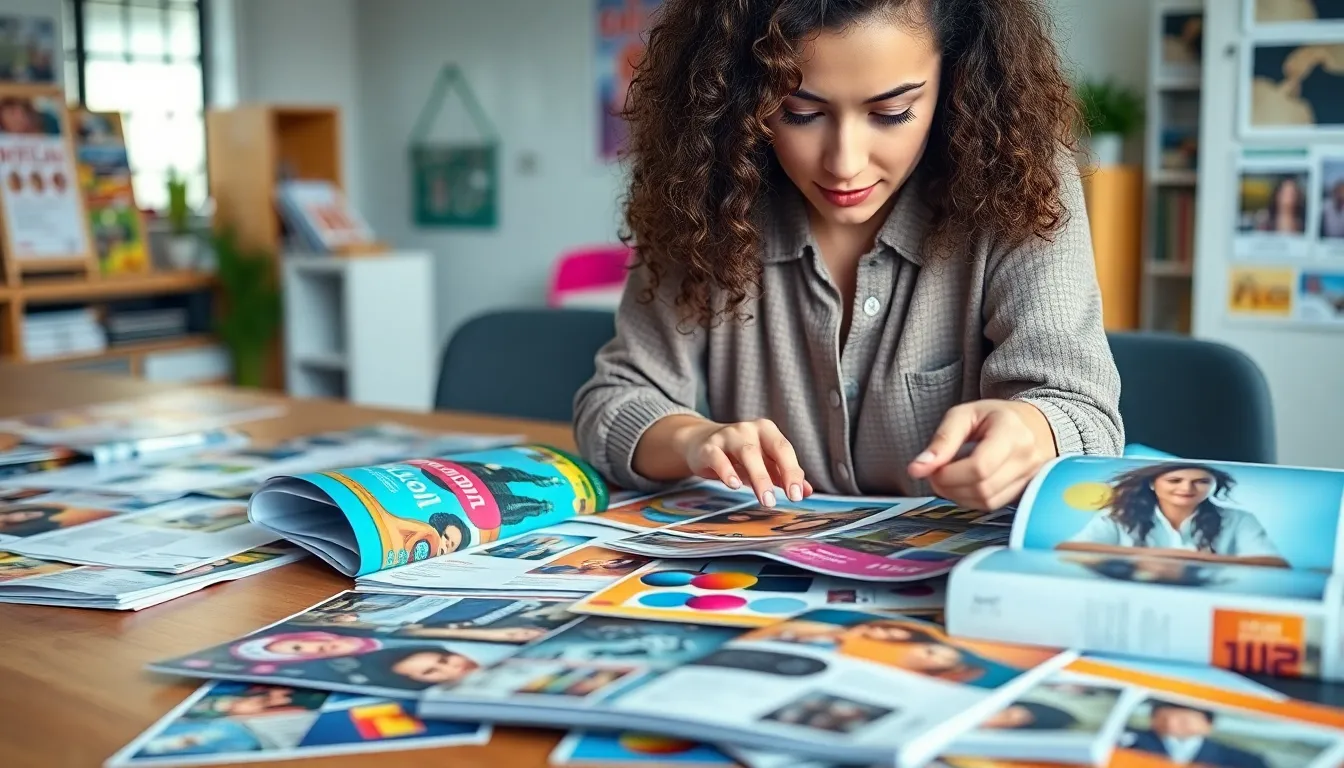In a world dominated by digital media, print design still holds a unique charm and effectiveness. It brings ideas to life through tangible materials, captivating audiences in ways that pixels alone can’t. From brochures to business cards, mastering print design techniques is essential for anyone looking to make a lasting impression.
Understanding the fundamentals of print design can elevate a project from ordinary to extraordinary. Techniques like color theory, typography, and layout play crucial roles in creating visually appealing designs. By harnessing these elements, designers can communicate messages clearly and engage viewers, ensuring their work stands out in a crowded marketplace.
Table of Contents
ToggleOverview of Print Design Techniques
Print design techniques include essential skills that enhance visual communication through printed materials. Mastery of these techniques allows designers to effectively engage audiences and convey messages with clarity.
Color Theory
Color theory encompasses the study of how colors interact and their emotional impact. Designers utilize color wheels, complementary colors, and color harmony to create visually appealing designs. Each color evokes specific feelings; for instance, blue conveys trust while red signifies energy. Using color strategically can reinforce brand identity and message.
Typography
Typography involves the art of arranging type to make written language legible and visually appealing. Designers select typefaces, adjust font sizes, and incorporate spacing to enhance readability. Effective typography supports the hierarchy of information, guiding the viewer’s attention through the design. Pairing fonts thoughtfully enhances aesthetic appeal and communicates tone.
Layout
Layout refers to the arrangement of visual elements on a printed page. Designers consider balance, alignment, and proximity to create a cohesive look. Utilizing grids aids in maintaining consistency and structure throughout the design. Effective layout balances text and images, ensuring each element complements the overall composition.
Print Techniques
Print techniques include methods such as offset printing, digital printing, and risography. Each technique offers unique benefits, influencing design choices based on project requirements. Offset printing provides high-quality results for large runs, while digital printing allows for quick, cost-effective solutions. Understanding these techniques helps designers select appropriate methods for their projects.
Imagery
Imagery plays a crucial role in print design. High-resolution images, illustrations, and graphics enhance visual storytelling. Designers choose images that resonate with the target audience and align with the overall message. Proper image placement and scale contribute to the design’s effectiveness, drawing the viewer in and creating a lasting impression.
By mastering these print design techniques, designers enhance their ability to create effective and engaging printed materials.
Essential Elements of Print Design

Effective print design hinges on key elements that enhance visual communication. Mastering typography and color theory significantly improves engagement and clarity in print materials.
Typography
Typography transforms textual content into compelling visuals. Designers must select fonts that align with the brand’s voice while ensuring readability. Effective font pairing creates hierarchy; for instance, a bold headline paired with a lighter body font directs attention appropriately. Proper spacing between letters, words, and lines enhances legibility and aesthetic appeal. Utilizing contrasting font sizes helps emphasize important information and facilitates navigation within the design. The consideration of typefaces, such as serif for traditional contexts and sans-serif for modern designs, influences the overall perception, thus enhancing viewer engagement.
Color Theory
Color theory plays a pivotal role in creating impactful designs. Understanding color relationships, including complementary, analogous, and triadic schemes, aids in crafting a cohesive palette. Designers should leverage color psychology, where specific hues evoke emotions; for example, blue instills trust, while red incites excitement. Consistent branding relies on a defined color palette, reinforcing brand identity across various materials. Effective use of contrast ensures vital elements stand out against backgrounds, facilitating communication. Additionally, designs should maintain color harmony to prevent visual fatigue, leading to a pleasurable viewing experience.
Common Print Design Techniques
Print design techniques enhance visual communication and attract audience engagement. Mastery of layout, composition, and imagery plays a critical role in achieving these goals.
Layout and Composition
Layout and composition structure visual design elements to create harmony and clarity. Designers apply grids to organize content systematically, ensuring balance across the design. Effective layouts guide the viewer’s eye, highlighting essential information.
- Hierarchy: Establish a visual hierarchy to prioritize elements. Use size and placement to direct attention.
- Alignment: Maintain consistent alignment for a polished look, which contributes to legibility and professionalism.
- White Space: Use white space effectively to prevent overcrowding and enhance focus on the main content. It helps separate elements, making information digestible.
Use of Imagery
Imagery significantly impacts the effectiveness of print design. High-quality images capture attention and convey messages more powerfully than text alone.
- Resolution: Select high-resolution images to ensure clarity in print, preventing blurriness or pixelation.
- Relevance: Choose images that resonate with the content and target audience, reinforcing the message.
- Placement: Position images strategically within the layout to create visual balance and enhance storytelling. Proper integration of imagery can foster emotional connections with the audience.
By effectively employing layout and imagery techniques, designers create visually captivating print materials that communicate messages clearly and resonate with viewers.
Advanced Print Design Techniques
Advanced print design techniques elevate the effectiveness of printed materials by enhancing engagement and visual appeal. Key applications for brochures and posters showcase these methodologies.
Techniques for Brochures
Brochure design relies on clarity and organization to convey information effectively. Designers can implement the following techniques:
- Fold Types: Utilize different fold types, such as tri-fold or z-fold, to create dynamic layouts that guide readers through the content. Various folds can generate visual interest and impact.
- Consistent Branding: Ensure cohesive branding by maintaining a unified color palette and typography throughout the brochure. This consistency strengthens brand recognition.
- Hierarchy: Establish a clear hierarchy using font sizes, weights, and colors. Larger headings and bold fonts draw attention to key messages, while subheadings can guide readers into detailed information.
- Engaging Imagery: Incorporate high-quality images that resonate with the target audience. Visual elements should be relevant and strategically placed to enhance storytelling.
- Call to Action (CTA): Include prominent CTAs that encourage reader response. Phrases like “Learn More” or “Contact Us” should stand out, prompting immediate interaction.
Techniques for Posters
- Bold Typography: Use bold, large fonts to convey the poster’s message immediately. This approach ensures readability from a distance and attracts viewer attention.
- Contrast: Leverage contrast to enhance visibility and guide focus. High contrast between elements draws attention to key pieces of information or imagery.
- Visual Balance: Strive for visual balance by distributing elements evenly across the poster. Symmetrical and asymmetrical arrangements can create harmony, keeping the design engaging.
- Negative Space: Employ negative space effectively to prevent clutter. This technique allows important elements to breathe and enhances overall clarity.
- Limited Text: Limit text to essential phrases or slogans. Concise messaging maximizes impact and ensures message retention in fleeting instances of viewer engagement.
Tips for Effective Print Design
- Choose colors strategically. Consider color theory principles to evoke emotions and reinforce brand identity. Use complementary colors to create a dynamic visual appeal and ensure that the colors align with the intended message.
- Select fonts wisely. Pair fonts that complement each other, ensuring readability and aesthetic balance. Limit font choices to two or three in a design to maintain focus and create a cohesive look.
- Establish a clear layout. Utilize grids to align elements and create a visually pleasing composition. Incorporate white space effectively to prevent overcrowding and to guide viewer attention.
- Optimize imagery usage. Use high-resolution images that resonate with the audience and support the overall design. Ensure proper placement and contextually relevant imagery to enhance storytelling.
- Utilize balance and contrast. Create an effective hierarchy by balancing visual elements and using contrast to emphasize important information. This guides the viewer’s eye and ensures clear communication.
- Implement tactile elements. Consider the texture of printing materials. Utilizing different paper stocks and finishes can enhance the tactile experience, making the design more engaging.
- Incorporate calls to action. Position calls to action prominently within the design. Use compelling language and design techniques to ensure they capture attention and prompt responses.
- Test printed proofs. Before finalizing designs, print proofs to evaluate color accuracy, layout, and overall presentation. This step helps identify any adjustments needed for optimal results.
By applying these tips, designers can enhance the effectiveness of their print materials, ensuring they not only catch the eye but also communicate messages clearly and effectively.
Mastering print design techniques is crucial for any designer looking to make a lasting impact. By understanding the interplay of color, typography, layout, and imagery, designers can create print materials that not only capture attention but also communicate messages effectively.
With the right approach to these elements, print design can stand out in a digital landscape, offering a tactile experience that engages audiences on a deeper level. Implementing practical tips and advanced techniques ensures that printed materials resonate with viewers, reinforcing brand identity and driving action.
Ultimately, the art of print design remains a powerful tool in effective communication, bridging the gap between creativity and strategy.

